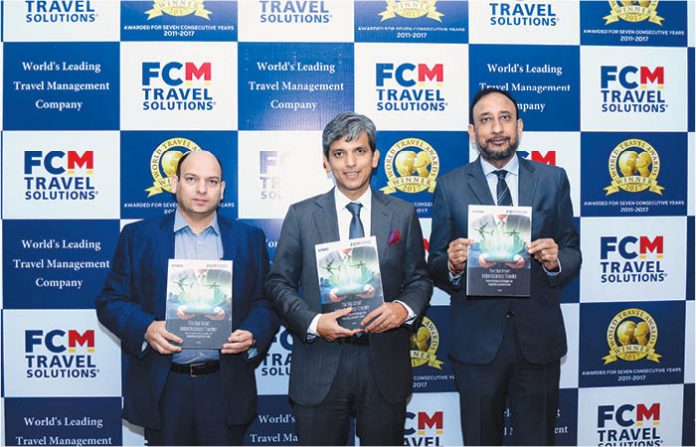FCM Travel Solutions, and KPMG recently released industry’s first insights on disrupting technologies in the travel industry via an analytical whitepaper titled ‘The Digi-Smart Indian Business Traveller’. Rakshit Desai, MD, FCM Travel Solutions, tells us more.
Kanchan Nath
NEW TECH ADOPTION In the new age era, the trends of the business travel is seeing a holistic surge in terms of usage of technology. Travellers now want limitless, yet seamless possibilities for travel. Elaborating on the same, Desai said, “This is our second publishing of our annual white paper on the status of the business travel market in India that also includes some of the early emerging themes, trends, technological developments and topics of interest for the industry.” The key findings insinuate on the technology adoption along with self-booking tools for business travellers. About the key findings, Desai added, “We are seeing some interesting developments in areas like new technology adoption. Self-booking tools, travel analytics, Artificial Intelligence and sharing economy services are not only here to stay but hold myriad and exciting possibilities for the future. The early indicators of potential applications for artificial intelligence technology and machine learning capabilities. Some of the more recent developments in encryption capabilities that come with block chain.” On adoption of technology happening in 2018, he said, “The necessary preconditions are set. The bandwidth is looking good. Hardware capabilities are good. Mobile penetration is still on the up. With Jio accelerating its push into more remote areas. Internet access is going to come to hundreds and millions of users. High bandwidth mobile access is going to be available to them. So, I think the necessary pre-conditions are set. Its up to players like us, who compete in this space to make products and services that are relevant for those users. If we can do that we will see some very interesting things play out in the next year or so.” The Indian business traveller is still experimenting with the trends in business travel. Elaborating on what technology presents to the Indian business traveller currently and what to expect, he said, “For the customer obviously, there are price advantages because its more efficient to serve them and therefore economies of scale can be passed on to them and that means lower prices. It means more control because you have fasttracked access to information, almost real-time information availability. That gives you greater deal of control and flexibility and agility in the way you manage your business and the travel aspects of what’s needed to run your business more successfully. Also, there is a high degree of transparency. Because price transparency is high and information asymmetry is low. That helps faster and better decision making.”
MICE TRENDS
The Indian MICE industry needs to buckle up to the current global trends. Desai, while highlighting the MICE trends adds, “I think we are going to see a lot more fragmentation of MICE business, whilst we will continue to see some momentum in large MICE events. Particularly as supply catches up in India and more cities can handle large groups of 1000-2000 delegates. Equally we are going to see a proliferation of small MICE groups. As companies segment their customers they will start segmenting their employees, dealer networks and there will be preferential treatment given to different levels of productivity. Different experiences will be attached to whether you are a high performing dealer, or you are an average dealer, whether you’re a top employee or you’re an average employee.” “For MICE we are looking at new destinations and products, MICE is a novelty business. You need to keep taking New ideas to clients and get them excited, otherwise they are reluctant to repeat the same kind of exercise, yearin and year-out. Earlier MICE programmes used to be very structured. They used to be scripted, you either fit in or don’t. With technology and online registration capabilities, a lot of our clients are wanting to inject a lot of flexibility into those programmes or MICE events. All the logistics complexity around that is handled by machines seamlessly. We can minimise both the cost and inventory utilisation risk for the sponsors. Its an evolving space. The biggest supply constraint on MICE right now, since demand conditions are very good, is the ability of embassies to turn around visa applications.”
RETROSPECT 2017, PROSPECT 2018
On their growth in 2017 and prospects for 2018, he added, “2017 was a blockbuster year for us, we have delivered, record growth rates and business volumes. 2018 has started on a positive note. We remain optimistic about our growth prospects. As we look back towards the last 18 to 20 months, significant disruptions have taken place in this marketplace, both at a macro economic level and at a geopolitical level. Despite that demand is good. We are looking to bring SAM to India, it’s a global tool with artificial intelligence capabilities with predictive handling capabilities. We have had some expression of interests from clients who would be interested in deploying that. Equally we are building a suit of products and services that could provide similar capabilities to Indian travellers at Indian price points as well. There would be plenty to look forward to with options of choice.”
MORE CUSTOMISATION WITH PROLIFERATION OF CHOICE
On disruptors and disruption, Desai concluded, “Mobility is not a disruption. What’s happening is the proliferation of choice in terms of the products and services that one can consume, also, the channels through which one can interact with service providers; earlier there were only physical interactions. Between face ID and biometrics, you will not have to go through your normal check-in procedures. There will be sophisticated algorithms connected to cameras running in the background, that will positive ID for you and allow you to board or not board, check-in or not check-in. Before we reach that crucial stage important facts of safety and data protection needs to be addressed. I’m not quite sure if I want my biometrics data sitting at a hotel or airport server somewhere. The debate carries on publicly till date.”















